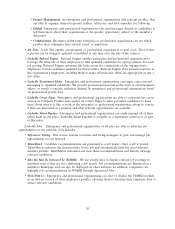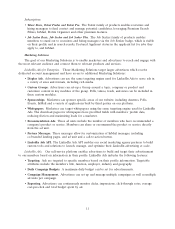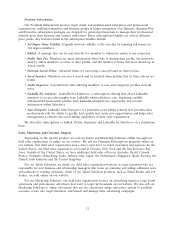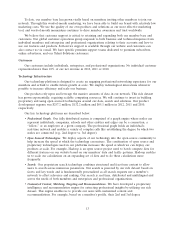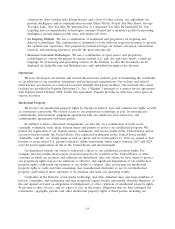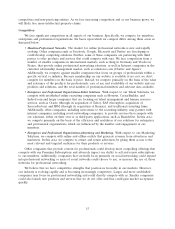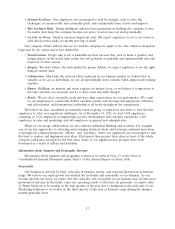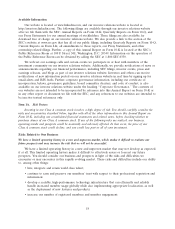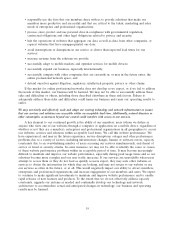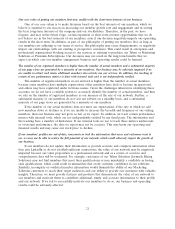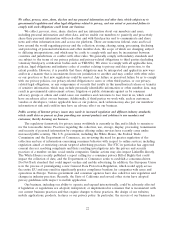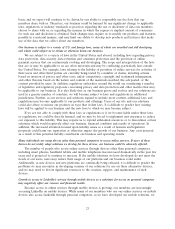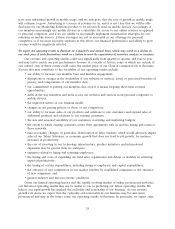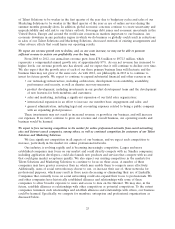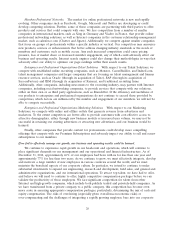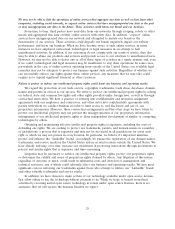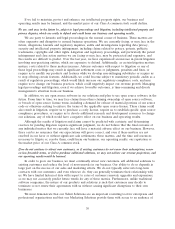LinkedIn 2012 Annual Report Download - page 22
Download and view the complete annual report
Please find page 22 of the 2012 LinkedIn annual report below. You can navigate through the pages in the report by either clicking on the pages listed below, or by using the keyword search tool below to find specific information within the annual report.We have implemented a disaster recovery program, which allows us to move production to a back-up
data center in the event of a catastrophe. Although this program is functional, it does not yet provide a
real-time back-up data center, so if our primary data center shuts down, there will be a period of time
that our services will remain shut down while the transition to the back-up data center takes place.
Our systems are also vulnerable to damage or interruption from catastrophic occurrences such as
earthquakes, floods, fires, power loss, telecommunication failures, terrorist attacks and similar events. Our
U.S. corporate offices and certain of the facilities we lease to house our computer and
telecommunications equipment are located in the San Francisco Bay Area and Southern California, both
regions known for seismic activity. Despite any precautions we may take, the occurrence of a natural
disaster or other unanticipated problems at our hosting facilities could result in lengthy interruptions in
our services.
We do not carry business interruption insurance sufficient to compensate us for the potentially
significant losses, including the potential harm to the future growth of our business that may result from
interruptions in our service as a result of system failures.
If our security measures are compromised, or if our websites are subject to attacks that degrade or deny the
ability of members or customers to access our solutions, or if our member data is compromised, members and
customers may curtail or stop use of our solutions.
Our solutions involve the collection, processing, storage, sharing, disclosure and usage of members’
and customers’ information and communications, some of which may be private. We are vulnerable to
computer viruses, break-ins, phishing attacks, attempts to overload our servers with denial-of-service or
other attacks and similar disruptions from unauthorized use of our computer systems, any of which could
lead to interruptions, delays, or website shutdowns, causing loss of critical data or the unauthorized
disclosure or use of personally identifiable or other confidential information, such as credit card
information. For example, in June 2012, we learned that approximately 6.5 million of our members’
encrypted passwords were stolen and published on an unauthorized website. If we experience
compromises to our security that result in website performance or availability problems, the complete
shutdown of our websites, or the loss or unauthorized disclosure of confidential information, our members
or customers may be harmed or lose trust and confidence in us, and decrease the use of our website and
services or stop using our services in their entirety, we could be subject to liability and litigation, and we
would suffer reputational and financial harm. Additionally, we are, and in the future could be, subject to
regulatory investigations and litigation in connection with a security breach or related issue, and we could
also be liable to third parties for these types of breaches. For example, we work with third party vendors
to process credit card payments by our customers and are subject to payment card association operating
rules. If our security measures fail to protect this information adequately or we fail to comply with the
applicable operating rules, we could be liable to both our customers for their losses, as well as the vendors
under our agreements with them, we could be subject to fines and higher transaction fees, we could face
regulatory action, and our customers and vendors could end their relationships with us, any of which
could harm our business and financial results.
Unauthorized parties may also attempt to fraudulently induce employees, members or customers to
disclose sensitive information in order to gain access to our information or our members’ or customers’
information or access this information through other means, or abuse our systems in ways that otherwise
degrade our users’ experience with LinkedIn, such as sending numerous unsolicited emails. Because the
techniques used to obtain unauthorized access, disable or degrade service, or sabotage systems change
frequently, often are not recognized until launched against a target and may originate from less regulated
and remote areas around the world, we may be unable to proactively address these techniques or to
implement adequate preventative measures. Any or all of these issues could negatively impact our ability
to attract new members and increase engagement by existing members, cause existing members to close
their accounts or existing customers to cancel their contracts, subject us to third-party lawsuits, regulatory
fines or other action or liability, thereby harming our operating results.
20


